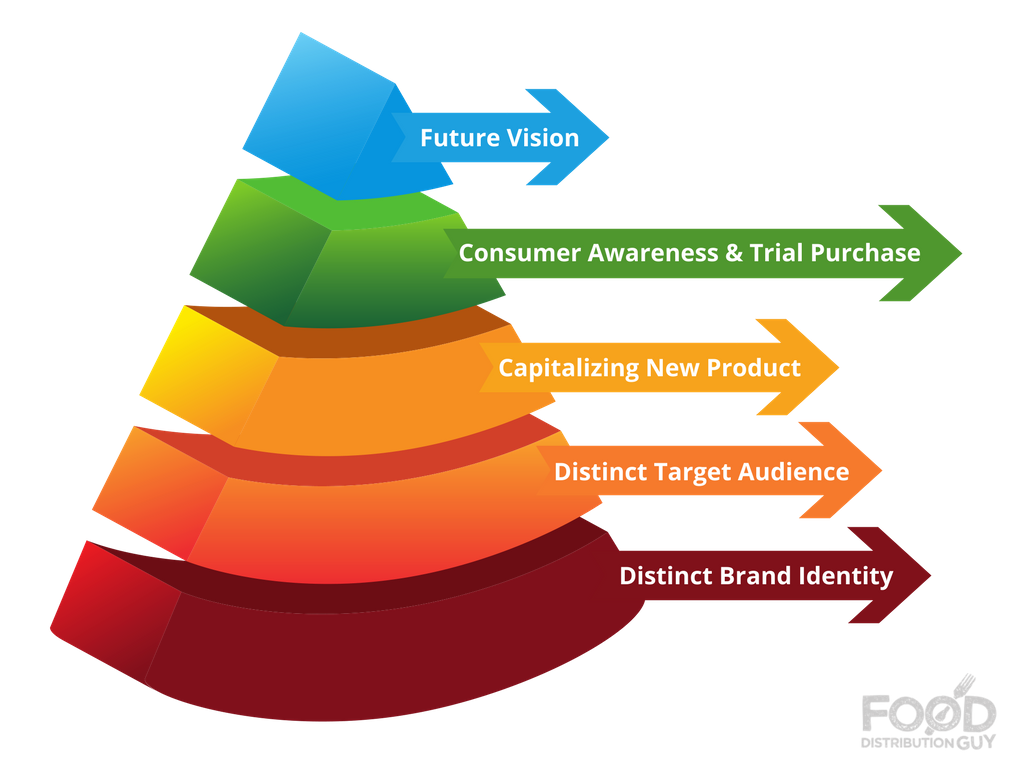FOOD DISTRIBUTION GUY’S HIERARCHY OF NEEDS FOR A SUCCESSFUL GROCERY STORE LISTING!
Maslow’s hierarchy of needs is a motivational theory in psychology comprising a five-tier model of human needs, often depicted as hierarchical levels within a pyramid. He stated that people are motivated to achieve certain needs and that some needs take precedence over others.
For business, a successful grocery store listing caps off their dreams. Like Maslow’s hierarchy, business must achieve certain needs before they attain their new grocery listing. Welcome to Food Distribution Guy’s Hierarchy of Needs for a Successful Grocery Store Listing!
Food Distribution Guy’s Hierarchy of Needs for a Successful Grocery Store Listing.
A Distinct Brand Identity is crucial to any new grocery listing. The brand represents business’s most valuable asset and unlike a product, it cannot be copied. The creation of the brand identity is a journey, not a sprint. It takes time and research to separate itself from the rest of the market to deliver distinguishing experiences for customers. The key 5 elements to a distinct brand identity:
- Vision: Answers the question What do we aim to achieve?
- Mission: Answers the question How do we plan to achieve this vision?
- Unique Selling Proposition: What differentiates your brand from the competition?
- Positioning: Defines the unique value you wish your customer to perceive compared to the competition.
- Personality: The human traits you wish to have associated with your brand. Consumers shop rationally, they purchase on emotion.
“Consumers Purchase the Brand, Not the Product”.
A Distinct Target Audience is essential in today’s market. Long gone are the days in which a one-size fits all strategy is successful. The key to identifying your ideal target audience is to reveal the pain point you wish to solve. At the root, a pain point is something that a customer is aware of and which bothers them. It’s a problem waiting for a solution. The worse the pain, or problem the greater the probability of selling your solution. When testing whether your business is addressing a real customer pain, answer the following:
- What pain does your company solve?
- Why should people care?
- Can you persuade people to purchase your product?
Identifying the pain point will allow you to zone in on your ideal consumer.
“What Pain Point Does Your Brand Solve”?
A Capitalizing New Product is an necessity. Retailers and consumers seek innovation, not knockoffs. “The key to launching a successful new product today is not only understanding your core and target shoppers but also how these shoppers view the C.P.G. (consumer packaged goods) marketplace,” said Susan Viamari, Vice-President, Thought Leadership, I.R.I. “Consumers think about satisfying needs in terms of eating occasions, drinking occasions and product usage occasions. C.P.G.s need to recognize which C.P.G. categories compete for each occasion. It varies by mindset, day part, channel, and shopper, so the days of one-size-fits-all strategies are gone forever.”[1] To be successful, your product launch must satisfy the consumer’s pain point.
“Does Your New Product Solve Your Target Audiences Pain Point?”
With the choices consumers have today, Consumer Awareness and Trial Purchase are essential to new product launches success; especially given the short probationary period (6-9 months) grocery banners give new entrants. Those entrants who feel their product will sell by itself, beware. No matter how good your product is, no one will buy if they don’t know it exists, and if they don’t understand and believe that it can meet their needs. The key to these 2 elements (consumer awareness and trial purchase) is a detail-oriented marketing plan. Yes, all business regardless of size requires a marketing plan. Though getting listed is difficult, it pails in comparison to the challenge new entrants face generating awareness and having that consumer dip into their wallets to make the purchase. Social media is key. It has leveled the playing field for small business to compete with more established brands. Engage in conversation with your target audience and be as transparent as possible. Do not be one of the 1 in 4 small business who are being left behind. According to the Clutch 2017 Small Business Social Media Survey, 24 percent of small businesses have zero social media presence.[2]
“What are Your Brands Key Tactics to Drive Brand Awareness and Trial Purchase”?
Many brands after their initial success seem to ignore their brands future. Future Vision is critical in the brands long-term journey. Do not be left behind. The competition, consumer and retailer demands keep evolving and so must your brand. This relates back to your initial brand vision – What do we aim to achieve. Change is not easy yet is inevitable and is the key to long-term success. Per Ralph Waldo Emerson:
“Do not go where the path may lead; go instead where there is no path and leave a trail”.
[1] Stand Out Product Launches in 2016, www.foodbusinessnews.com, Monica Watrous, December 2016
[2] 24 Percent of Small Businesses Do Not Use Social Media – At All, www.smallbiztrends.com, March 2017






